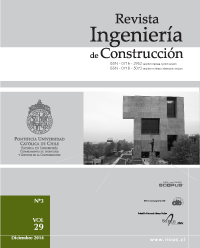Influence of fiber volume and subsequent curing on post - crack behavior of an ultra high performance concrete (UHPC)
DOI:
https://doi.org/10.4067/S0718-50732014000300001Keywords:
Ultra high performance concrete (UHPC), compressive strength, postcracking, fiber reinforced concrete, flexural strengthAbstract
In this paper the performance of an Ultra-High Performance Concrete (UHPC) reinforced with different contents of metal fibers is evaluated. This concrete was produced using materials available in Colombia and conventional manufacturing techniques;, ie no high temperatures or pressures in the manufacturing of different specimens were used. This UHPC was tested for uniaxial compressive strength and flexural strength. Furthermore, we evaluated the behavior of different ages cracked joists of different ages, which were subjected to different curing times in order to determine the residual bending strength., was evaluated. It has been observed We observed that the fiber content and adhesion to be generated between them the fibers and the concrete matrix are matters of great importance, in order to ensure no loss of flexural strength, regardless of the age of the cracking.


